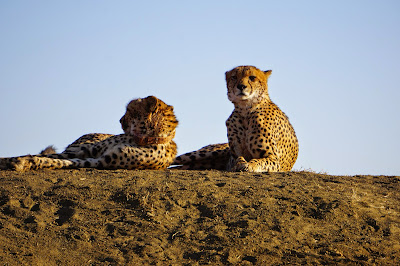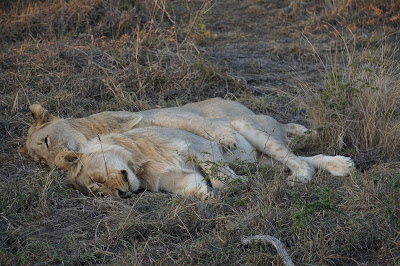When last we left our story, our helicopter was just arriving. It landed and picked up the vet, one of his interns (there were 3 young ladies from the US), and a niece of Sean’s. Brenna is from Indiana, and had just been home from a mission in Thailand for about 3 months. She graduated from BYU (communications) before her mission, and since coming home already had a job as a news anchor in a smaller city in Texas.
After about 10 minutes they
radioed back and said they had spotted 2 black rhinos. The black rhinos
are extremely rare so everyone was very excited about that. This vet had
tagged 232 rhinos up until that time, but had never tagged a black rhino.
The pilot said there was a mother and a larger calf together and the calf
had an injured leg. The vet wanted very much to treat the
calf’s injuries along with tagging it.
 |
| The veterinarian |
The helicopter flew back,
the vet prepared the tranquilizer dart and they took off again. The rest
of us piled into three vehicles and headed to the area where the rhinos were
spotted.
While following the helicopter, we came across the largest herd
of giraffes we had ever seen. There were close to 20 giraffes with their
babies. We didn’t have time however, to stop and get a good look at
them or take decent pictures.
 |
| Off we go |
As we drove, the helicopter flew back towards the black rhinos
again. But they flew around searching for almost 30 minutes, until we
thought they were going to run out of gas and have to abort the whole
activity. That was very nerve-racking for all of us. Finally it was
decided they had to give up on the black rhinos and look for a white one.
Within about 5 minutes they
had two spotted and were chasing them to where our vehicles were parked.
All of a sudden we saw this rhino come crashing out of the brush towards the
road right by us. We could see she had a dart stuck in her rear.
She came to a stop about 20 feet from the road and just kind of stood there
frozen.
Her sister then appeared out of nowhere and ran circles around her
several times, trying to encourage her to get moving. At one point the sister even nudged her. The
helicopter had to swoop down to try to scare off the sister. After several
attempts, the sister ran off into the bush. The darted rhino’s knees buckled and she just kind of collapsed, going down in a kneeling position.
One of the senior sister
missionaries had the assignment of throwing a towel over the rhinos eyes, and
another one stuffed socks into each of her ears. That was to try to
soften the impact of what was going on around her.
 |
| Marking and cutting the ears |
They marked each ear with a marker for 3 notches in a particular pattern. The number and position of the notches makes it possible to identify the rhinos from the air. Our rhino was number 233. He then took a big pair of cutters and cut the notches in her ear.
 |
| Putting ointment on her ears |
That was just like cutting into a heavy weight leather belt. They then put some ointment on the ears to clean the cuts and help stop the bleeding.
The next order of business
was to drill about a 3/16” diameter hole into each of the two horns and insert
a microchip. If police ever found the horns in someone’s possession, they
could prove their origin in that way.
Another microchip was inserted beneath
the skin behind one of her ears. A piece of hair was pulled out of her
tail to use for a DNA sample.
 |
| This horn is worth $65,000 to poachers |
All during the time the rhino
was down, Sean’s niece, Brenna, was doing little “interview shots” around Lady
Grace. Sean would turn on the camera, and she would say something like
“you can see now that Doctor Everett is drilling a hole in the horn of this 7
year old White Rhinoceros.” That was kind of fun to watch too. She
will take the footage back home and put together a little rhino piece.
The work is finished and it's time for some photos
 |
| Lady Grace |
After close to an hour, we
all got back into our vehicles and the vet gave Lady Grace an
antidote shot. Within 1 minute she was up on her feet, and within another
minute, she trotted off into the brush.
















































